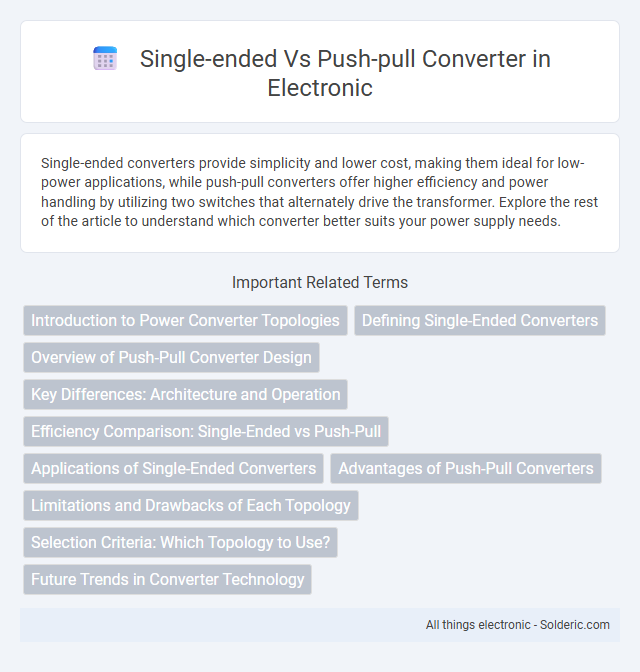Single-ended converters provide simplicity and lower cost, making them ideal for low-power applications, while push-pull converters offer higher efficiency and power handling by utilizing two switches that alternately drive the transformer. Explore the rest of the article to understand which converter better suits your power supply needs.
Comparison Table
| Feature | Single-Ended Converter | Push-Pull Converter |
|---|---|---|
| Topology | Single switch and transformer | Two switches, center-tapped transformer |
| Power Handling | Low to moderate power levels | Moderate to high power levels |
| Efficiency | Lower due to core saturation and losses | Higher efficiency, better transformer utilization |
| Transformer Size | Larger magnetic core required | Smaller core, better utilization of transformer |
| Switch Stress | High voltage and current stress on single switch | Reduced stress, split between two switches |
| Complexity | Simple design, easier to implement | More complex due to two switches and drive circuitry |
| Cost | Lower cost due to simpler design | Higher cost because of additional components |
| Applications | Low power adapters, simple isolated power supplies | Medium to high power supplies, efficient DC-DC converters |
Introduction to Power Converter Topologies
Single-ended and push-pull converters are fundamental power converter topologies used in DC-DC conversion applications. Single-ended converters utilize a single transistor and transformer winding, offering simplicity and cost-effectiveness but with limited power handling and efficiency. Push-pull converters employ two transistors and transformer windings that operate alternately, providing higher power output, better transformer utilization, and improved efficiency in medium to high power designs.
Defining Single-Ended Converters
Single-ended converters are a type of DC-DC converter that use a single switching element, typically a transistor, to transfer energy from the input to the output through a transformer or inductor. These converters are simple in design and cost-effective, making them suitable for low to medium power applications. They differ from push-pull converters, which utilize two switches to alternately drive the transformer, providing higher efficiency and better power handling.
Overview of Push-Pull Converter Design
Push-pull converter design utilizes two transistors that alternately switch, driving the transformer's primary winding in opposite directions to improve efficiency and power handling. This topology enables better transformer utilization and reduced voltage stress across switching devices compared to single-ended converters. Key components include a center-tapped transformer, synchronized switches, and a control circuit to manage conduction timing for optimized energy transfer and reduced electromagnetic interference.
Key Differences: Architecture and Operation
Single-ended converters utilize a single switching device and transformer winding, resulting in simpler architecture but lower efficiency and higher ripple in output voltage. Push-pull converters employ two switches and a center-tapped transformer, enabling improved power handling, better efficiency, and reduced output ripple due to balanced current flow. Understanding these architectural and operational differences helps you select the appropriate converter based on power requirements and performance needs.
Efficiency Comparison: Single-Ended vs Push-Pull
Push-pull converters generally offer higher efficiency than single-ended converters due to improved transformer utilization and reduced core losses. Single-ended converters suffer from increased switching losses and lower power handling capabilities, impacting overall efficiency in high-power applications. Your choice between the two should consider the efficiency benefits of push-pull designs, especially for medium to high power levels.
Applications of Single-Ended Converters
Single-ended converters are commonly used in low-power applications such as battery chargers, small LED drivers, and simple power supplies due to their straightforward design and cost efficiency. Their ability to handle low to moderate voltage and current levels makes them suitable for consumer electronics and portable devices. Your projects can benefit from single-ended converters when requiring compact, reliable, and energy-efficient power conversion with minimal complexity.
Advantages of Push-Pull Converters
Push-pull converters offer higher efficiency and better power handling capability compared to single-ended converters due to their use of two transistors that alternately switch, minimizing voltage stress and transformer core saturation. They provide improved transformer utilization and reduced electromagnetic interference (EMI) by balancing the magnetic flux in the transformer core. This architecture also supports higher output power levels and enhanced thermal performance, making push-pull converters ideal for medium power applications.
Limitations and Drawbacks of Each Topology
Single-ended converters often suffer from limited power output and lower efficiency due to their inability to fully utilize the magnetic core, causing increased flux imbalance and core saturation risks. Push-pull converters, while offering higher power capacity and improved efficiency, face challenges such as transformer saturation caused by unequal switching times and increased electromagnetic interference (EMI). Understanding these limitations helps you select the appropriate topology matching your power conversion needs and application constraints.
Selection Criteria: Which Topology to Use?
Single-ended converters are ideal for low-power applications due to their simplicity, cost-effectiveness, and minimal component count, making them suitable for designs with limited space and lower efficiency demands. Push-pull converters are preferred for medium to high-power ratings because they provide better transformer utilization, higher efficiency, and improved voltage regulation under varying load conditions. The choice between single-ended and push-pull topologies depends primarily on power level requirements, efficiency targets, and complexity constraints within the power supply design.
Future Trends in Converter Technology
Future trends in converter technology emphasize enhanced efficiency and miniaturization through advanced semiconductor materials like GaN and SiC, which excel in both single-ended and push-pull topologies. Push-pull converters benefit from improved magnetic component designs and integrated control ICs, leading to better power density and reduced electromagnetic interference. Single-ended converters continue evolving with synchronous rectification and digital control techniques to meet the growing demands of IoT and electric vehicle power systems.
single-ended vs push-pull converter Infographic

 solderic.com
solderic.com